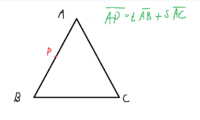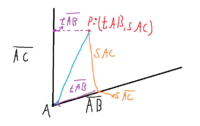Show that a point P is on a triangel ABC if and only if [MATH]\vec{AP}=t\vec{AB}+s\vec{AC} [/MATH] where [MATH] s,t \geq 0, s+t \leq 1[/MATH]
Hey, I have no idea how to prove this or even where to begin. I tried drawing a triangle with the labels ABC and drew out a random point P on the triangle but I don´t see how I would satisfy the proof. My picture is a bit boring since it doesn´t really show anything special but I guess it´s better to include it than to not include it!
Thanks in advance.

Hey, I have no idea how to prove this or even where to begin. I tried drawing a triangle with the labels ABC and drew out a random point P on the triangle but I don´t see how I would satisfy the proof. My picture is a bit boring since it doesn´t really show anything special but I guess it´s better to include it than to not include it!
Thanks in advance.


